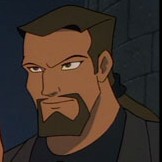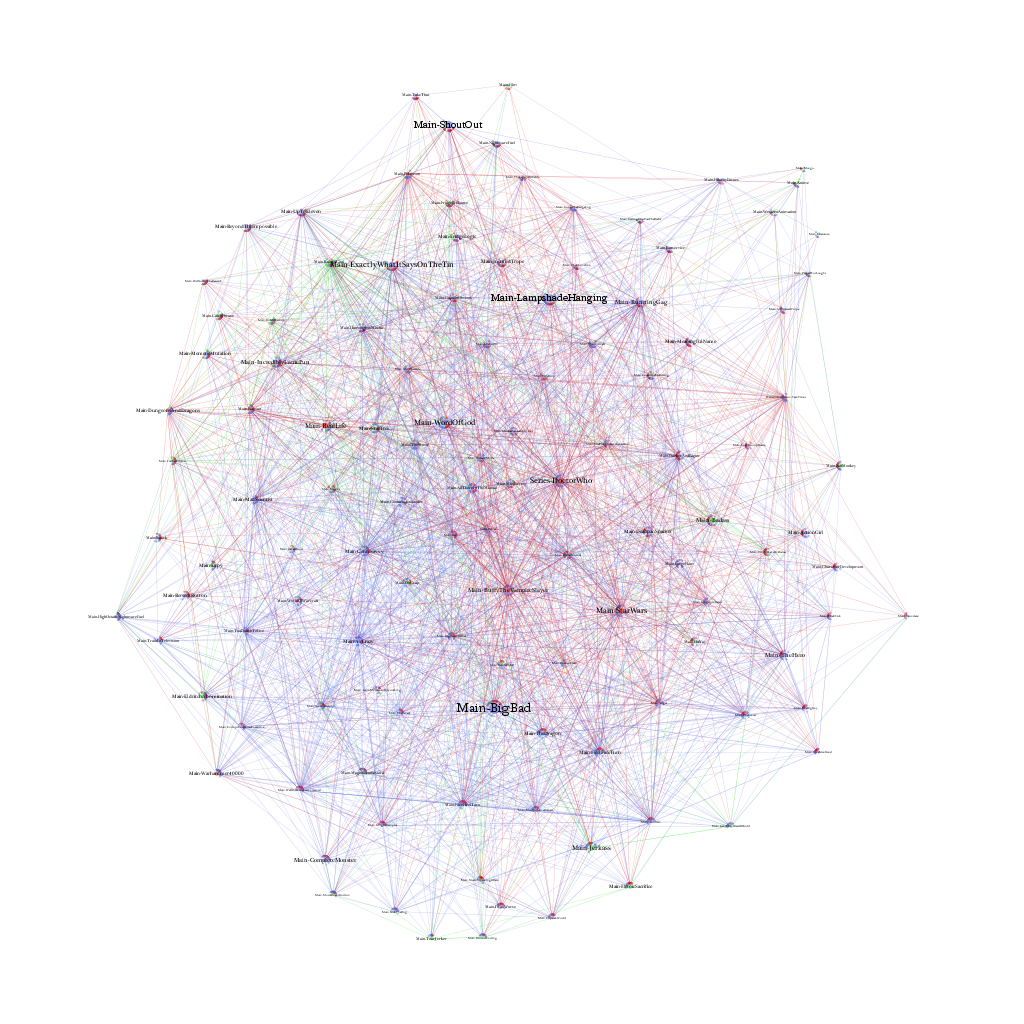Part 2: Trope (but not Troper) Communities
Part 3: If you liked Dwarf Fortress, you’ll love Twilight: Breaking Dawn
Example of Thematic Relationships
HP Lovecraft popularized a certain type of malevolent force, something so massive and powerful and unconcerned and out-of-scale with humanity that we could not even understand the whole of it. Instead, his characters would–before inevitably going mad–only experience a small portion of these beings, typically some kind of horrid extrusion into our reality. There is much that these Eldritch Abominations have in common with the kind of massively peer-produced content that floats like icebergs in the Internet. Wikipedia, both prototype and archetype, showed how large and important, but also arcane and unseemly, these works could be. Far smaller and not as well known, but still one of these icebergs, is TV Tropes.

The success of Wikipedia spawned many Wikipedia-like enterprises–the road is littered with those that aimed at replicating Wikipedia’s core mission, such as Knol and Citizendium, as well as attempts at using the wiki format for less structured and less staid content, such as the now-moved-to-.ch Encyclopedia Dramatica. But TV Tropes seems to have found a niche, and while it does not have the millions of articles that Wikipedia has, nor the top 10 Alexa ranking, it holds enough mind-share to warrant a reputation for its addictive quality.
Tropes, per the usage of the term on TV Tropes, can refer to most any element that appears within a story as well as the elements of story particularly as they relate to a modern culture that not only reads or watches such a thing but also actively theorizes about it, writes fiction about it on the Internet, and otherwise feels actively engaged with the work. For example, TV Tropes includes not only the Twist Ending, but also a particular kind of twist ending that is notable not for what happens in the story but for how the story has been framed and is dealt with by the cinema-going community at large.
When I asked the folks who run TV Tropes to give me their database, I actually expected it to be both larger and smaller. Compared to Wikipedia, the actual content is miniscule, with only 23,032 pages of tropes and 26,350 pages of works along with 1831 index pages. But these 50,000 or so pages are connected by over 3.4 million links between them, comprising of links to similar tropes from trope pages to trope pages, links from trope pages to works where the tropes can be found, and indexes that act as a partial level of curation over the entire endeavor. You could see this as a network visualization of pages that point to each other, at least theoretically.

The 54 most central pages on TV Tropes, considering only links between trope, work and index pages. Tropes are in blue, works are in red and indexes are in green. To disambiguate names, the namespace is appended to the trope, index or work name.
But this brings me back to the problem of the Eldritch Abomination. You see, TV Tropes is so densely interlinked, with some pages having thousands of links to them and thousands of links to other pages, that any attempt to visualize more than a trivial piece of it using traditional network visualization results in a giant ball of edges that resembles a well-known entity.
The way in which TV Tropes analyzes a wide variety of works, including how modern works interact with an Internet-enabled community, as well as how TV Tropes self-organizes, may prove useful in the analysis of literature and other media. That said, while it may provide some attractive poster options for undergraduates, the visualization of 50,000 nodes and 3.4 million edges from the project would be just one limited view of the unspeakable horror of the thing itself. To step away from the Lovecraftian metaphor and into analogies that Digital Humanities scholars are a bit more comfortable with, the TV Tropes project is like a commons-based form of distant reading, but instead of leveraging Natural Language Processing techniques, it takes advantage of open source processes to distill works into recognizable components. Interestingly, when I asked the administrators of the project what they felt they were doing, one response was:
What we do here? Pattern-spotting. Pattern analysis. Ingredient identification. By that last one, I’m talking about treating fiction the way some folks treat a food they’ve never had before; tasting it and then trying to figure out what all went into making it. “Hmmm, I can taste cinnamon. Or something like cinnamon, anyway. Wait, I don’t think it’s actually cinnamon, but it’s warm like cinnamon. I think it may be … CUMIN? WTH? Cumin with apples? I never would have thought to put those two together. But it works.”
-Madrugada
Which is remarkably similar to the explanation Matt Jockers recently gave for how Topic Modeling works.
Having spent some time grappling with the TV Tropes dataset and speaking to the administrators of the project, it’s my hope that through a series of explorations of this vast network we can better understand the structure of the project and at least some of the patterns within it. I’ll begin in Part II with an overview of the slightly more manageable network of trope-to-trope connections, and then focus in Part III on some of the patterns that arise when examine particular works and tropes. After that, if there’s interest, I may return to the larger network as a whole and lay out some of its general structures both internally and with regard to the larger Internet.
UPDATED: A few folks have asked me to give a better explanation of how the TV Tropes network looks through something interactive. It’s a hard thing to do with any large portion of the network but here is a traversable network made up of the 148 most central indices, works and tropes using the excellent gexfjs library.





Unfortunately there’s a death Knol tolling:
http://knol.google.com
At least you can still get your data out…and that’s what matters: data portability and migration support for cloud-based services.
An important update about knol
Knol will be moving to Annotum on May 1, 2012
Knol will be discontinued as a service, but we’ve worked with Solvitor and Crowd Favorite to create Annotum, an open-source platform based upon WordPress that allows you to continue authoring and publishing scholarly articles. You can migrate your knols to WordPress and continue your work with Annotum. After May 1, you will no longer be able to create, view, enter or edit knols, but you will be able to export your knols to WordPress.com and download them to file through October 1st, 2012.
To learn more about this announcement, see our Frequently Asked Questions.
Export my knols to WordPress.com
(Just a few simple steps to keep your content on the web)
Download my knols to a file
(Save a copy and set up redirects. You can still export to WordPress.com later)
TVTropes also has a reputation for its insular, anti-intellectual, and bigoted userbase. Beware of lending it any credibility by association.
I’m aware of it, and I’m going to make mention of the seedier complaints lodged against the forum in a later post, but I’m not looking into that and, don’t worry, I’m not lending any more credibility to the site than anything else that links to it (I really don’t have the level of power or reputation to be any kind of credibility lender). Let’s keep in mind that any large community on the Internet, including Wikipedia and Something Awful (I’ve had a Wikipedia account for quite some time and I’m a goon, so I know this from the inside), has more than its fair share of seedy elements. That said, even if it turns out that TV Tropes is itself damaged beyond credibility, the phenomenon that it represents is interesting and worthy of examination.
As a regular editor on TV Tropes, I can assure you that this is not even close to an adequate encapsulation of the entire user base, nor would it be for any user base anywhere. Honestly, given the sharply negative tone of that piece, its status as a Something Awful topic and it being severely out of date (Fetish Fuel and Troper Tales no longer exist, for one), why are you even giving it any credibility as evidence against the site?
Jade,
I’m not aware of the quality of the criticism in the SA thread (which has apparently caused no end of consternation among the TV Tropes community) but I was aware of that kind of criticism–it had been brought to my attention by the admins at TV Tropes when I asked them about negative perceptions of their site. So, I allowed that comment (unlike so many other critical or aggressive comments) because I thought it would give readers an opportunity to see that criticism. My experience with a number of projects and groups like this has led me to feel that these kinds of critiques are common, something I tried to point out to the original commenter. I don’t feel that I’m lending it any credibility by leaving the comment up–it’s just another opinion.
I hope this doesn’t cause too much stress to folks.
As a different regular editor, I’d say that the criticism actually is mostly accurate. The wiki itself is great, but the surrounding community is an absolute headache to deal with, especially the folks in charge. More’s the pity, as it severely drags down what is otherwise an awesome project.
But I do look forward to more of your analysis.
That thread says a lot more about Something Awful than it does about TV Tropes.
Oh, those goons complain about everything. But let’s not go there. The wiki-side part of the wiki and the forum-side are two completely different communities.
But it’s interesting seeing these webs. TV Tropes has potential, but we’re yet to find all of it.
Validity of goon complaints about the forum aside (I have seen them, I feel they are valid, next question), I look forward to the further development of this project and what it means in regards to the structure of community-based ‘encyclopedia’ projects on the internet in general (if there are any generalisations to be made). I think there’s an interesting investigation to be made and good on you for pursuing it.
I especially look forward to Part III.